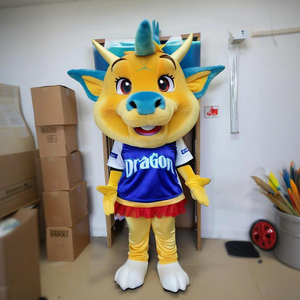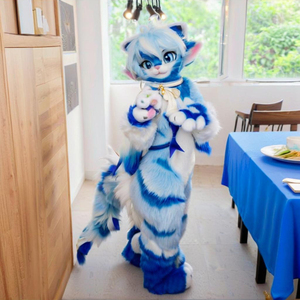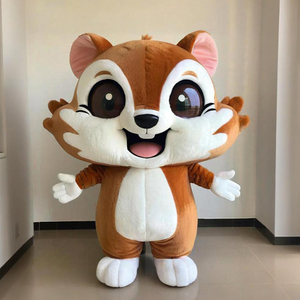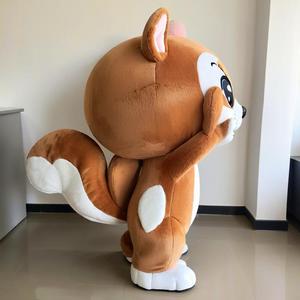
All categories
Featured selections
Trade Assurance
Buyer Central
Help Center
Get the app
Become a supplier

(1154 products available)














































Puppet mascots are an important part of any event as they help in the promotion of brands and give a lively atmosphere to an occasion. They are often made to look like characters that are associated with a brand or an organization, and they help to create a friendly and approachable image. There are different types of puppet mascots, each with its own characteristics and benefits.
Animal Puppet Mascots
Animal puppet mascots are the most common type. They are usually based on real or imaginary animals and have friendly and approachable personalities. These include bears, lions, eagles, and dragons. They are often used by schools, sports teams, and businesses because they can easily relate to people and create a bond with them. Bear puppet mascots, for instance, are commonly used by companies to symbolize strength and reliability, while lion puppet mascots are used to demonstrate courage and leadership.
Character Puppet Mascots
Characters from books, movies, and games inspire these puppet mascots. They often have well-established personalities and stories, which makes them easy to relate to and recognize. Examples include superheroes, cartoon characters, and video game heroes. They are often used for promotions and events because they are already popular with the public. For example, superhero puppet mascots are commonly used by schools and sports teams to symbolize justice and bravery, while cartoon character puppet mascots are preferred for their humor and fun-loving nature.
Food Puppet Mascots
These are based on different food items and, most of the time, have a positive and cheerful personality. They are commonly used by restaurants, food brands, and grocery stores. Some examples are fruits, vegetables, and snacks. For example, fruit puppet mascots are often used by juice and fruit companies to promote health and freshness, while snack puppet mascots are used by snack and food companies for their delicious and fun nature.
Human Puppet Mascots
These are based on historical figures, professions, or everyday people. They usually portray specific values or qualities and are used to represent organizations or causes. They can be athletes, workers, or cultural figures. For instance, athlete puppet mascots are commonly used by sports teams and schools to symbolize teamwork and dedication. On the other hand, human puppets that portray professionals are used by educational institutions and organizations to promote awareness of different careers.
Fantasy Puppet Mascots
These are based on mythical creatures. They usually have unique and interesting personalities and are great for creating a magical atmosphere. They include mascots like fairies, elves, and wizards. For example, fairy puppet mascots are often used by toy and children's companies to promote imagination and wonder, while wizard puppet mascots are often used by education and science organizations to symbolize knowledge and magic.
One of the key design elements in puppet mascots is their heads. This is where most of the personality and character are displayed. Their heads are usually big in proportion to their bodies. This is a stylized and exaggerated form. They are constructed from lightweight materials such as foam or fabric. This ensures ease of movement and comfort when worn for long periods. The facial features are painted or embroidered with bright and bold colors. This enhances visibility from a distance. The eyes are often oversized and animated. They create a friendly and approachable look. The mouth is movable and can be synchronized with the puppeteer's speech to perform realistic expressions.
In addition to the head, the body of a puppet mascot is another important design element. This part is usually constructed from a mesh and flexible material. This allows for free movement and ventilation. Its design is proportional to the head. They are often wearing a full-body costume. This is a representation of the character's attire or theme. The body is filled with soft padding. This helps in maintaining the mascot's shape and adds comfort when worn. The colors and patterns of the body are consistent with the overall theme. The body also includes limbs, which are articulated to some extent to enhance the performer's capability to express different emotions.
Some puppet mascots come with limbs while some do not. The limbs of puppet mascots are an essential part of their design. This part enables them to interact with their environment and audience. Their arms are usually long and articulated. This allows for a wide range of motions. The hands are often gloved and can have simple finger divisions or be one solid piece with exaggerated fingers. The legs are short and stout, designed for stability and ease of movement. The feet are large and flat. This makes the puppet easy to walk and perform. The limbs are constructed from lightweight materials and are covered in the same fabric as the rest of the mascot to maintain a cohesive look.
The costume of a puppet mascot is a complex design element. It consists of various materials and components. The outer layer is usually made from bright and durable fabrics. This is treated to withstand wear and environmental elements. The costume design incorporates multiple textures. This creates a dynamic visual appeal and invites touch. This includes smooth, fluffy, and sequined fabrics. The use of Velcro and zippers ensures easy wearing and removal. This facilitates quick changes when required. Additionally, the costume is adorned with accessories like hats, shoes, and props that are further enhance the character's identity and functionality.
Modern puppet mascot designs often incorporate innovative features that enhance their performance and usability. Some of these features include:
Puppet mascots can easily be worn by slipping the head of the wearer into the costume's body and placing the head of the wearer into the puppet's head. Some of the designs have suspenders to help the wearer keep the costume on while they walk around. Putting on a puppet mascot costume can be difficult, so it is recommended to have someone help the person getting into the suit. The hands of the wearer go inside the puppet's hands, and the feet of the wearer go into the shoes of the mascot. The final step is to adjust the head of the mascot to fit the wearer's head perfectly.
Some companies sell their puppet mascot costumes, while others have them custom made for the company. It is possible to rent a costume for a short time, and this is a good option for someone who needs the costume for a special occasion or event. Wearing a puppet mascot costume is fun and can be tiring. The person inside the costume must take breaks and drink water to keep going.
Matching a puppet to its mascot requires considering the personality and characteristics of the puppet. Start by identifying the key traits and features of the puppet. For example, if the puppet has a specific theme, such as a superhero, animal, or fantasy character, make sure the mascot embodies those qualities. Look for similarities in color schemes, costumes, and accessories. If the puppet has a distinct color palette, try to match it with the mascot's design. This helps create a cohesive and recognizable brand image.
Pay attention to the facial expressions and emotions of the puppet. The mascot should be able to convey similar feelings to connect with the audience. Consider the size and proportions of the puppet. Ensure the mascot is designed to fit the scale and dimensions of the puppet. This maintains visual harmony. Collaborate with a skilled designer or artist who can bring your vision to life. They can help create a mascot that complements your puppet's unique characteristics and personality.
Q1. What Are Puppet Mascots And Why Are They Used?
A1. Puppet mascots are larger-than-life puppets that stand as representations of organizations, squads, or corporations. They are made to entertain, bring people together, and foster a sense of belonging. They are often seen in events, promotions, or as part of a team’s spirit. They are known for their vivid personalities and are usually seen in schools, sports teams, and corporations.
Q2. How Do They Bring Life Into An Event?
A2. They are lively characters with strong voices, gestures, and interactions with the audience. They tell stories, act in skits, and mix with the crowd. Their charm and humor break the ice. Participants feel more relaxed and engaged. This creates a fun, memorable atmosphere that encourages bonding and cooperation among everyone present.
Q3. Can They Be Custom Made For A Specific Purpose?
A3. Yes, puppet mascots can be tailored to fit the characteristics and values of the organization they are representing. From design, name, and personality to the specific roles and activities the puppet will engage in, each aspect can be customized. This ensures that the puppet accurately reflects the brand and resonates with its target audience.
Q4. Are They Suitable For All Age Groups?
A4. Yes, they are well suited for both the young and the elderly. They have educational and entertaining value, which makes them ideal for children and adults. Their ability to adapt to different themes and complexities ensures that they can engage effectively with diverse audiences, making them a versatile tool for events, workshops, and promotions.